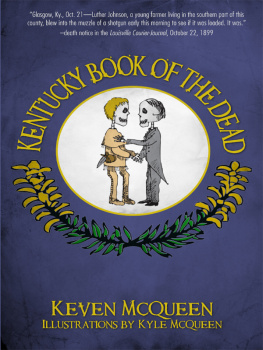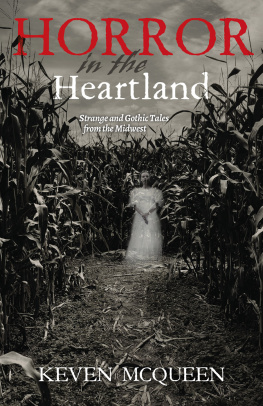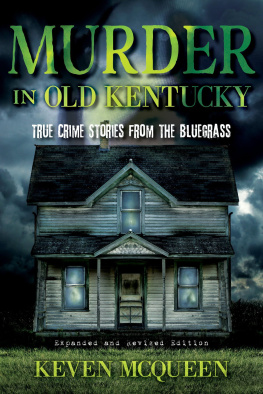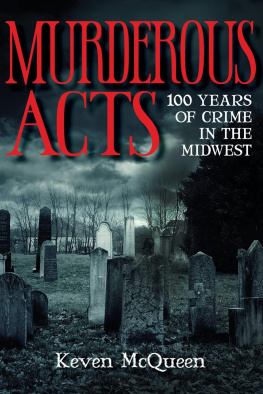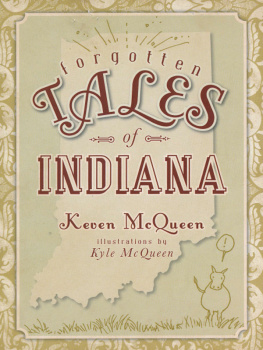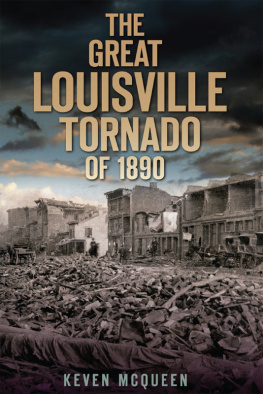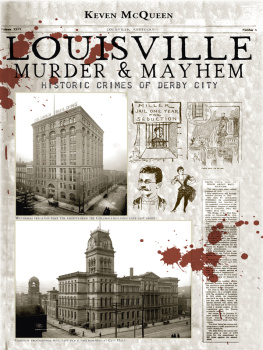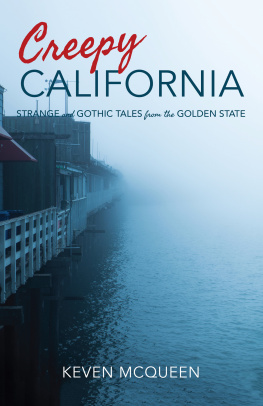

Published by The History Press
Charleston, SC 29403
www.historypress.net
Copyright 2008 by Keven McQueen
All rights reserved
All illustrations by Kyle McQueen
First published 2008
Second printing 2011
e-book edition 2012
ISBN 978.1.61423.438.8
Library of Congress Cataloging-in-Publication Data
McQueen, Keven.
Kentucky book of the dead / Keven McQueen ; illustrations by Kyle McQueen.
p. cm.
Includes bibliographical references.
print ISBN 978-1-59629-524-7
1. Ghosts--Kentucky. 2. Death--Kentucky--Miscellanea. I. Title.
BF1472.U6M44 2008
133.109769--dc22
2008021047
Notice: The information in this book is true and complete to the best of our knowledge. It is offered without guarantee on the part of the author or The History Press. The author and The History Press disclaim all liability in connection with the use of this book.
All rights reserved. No part of this book may be reproduced or transmitted in any form whatsoever without prior written permission from the publisher except in the case of brief quotations embodied in critical articles and reviews.
Dedicated to my grandparents:
Walker and Lellie McQueen and Jess and Della Casteel.
Its obvious that we dont know one millionth of one percent about anything.
Thomas Edison
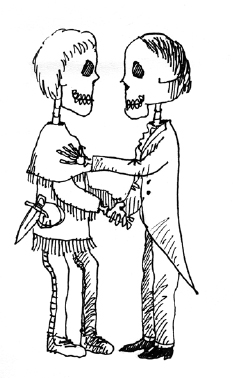
CONTENTS
A NOTE TO THE GENTLE AND PATIENT READER
There is neither rhyme nor reason to the organization of this book. It is not arranged chronologically and barely by topic. It is intended simply to be a mlange of bizarre incidents and entertaining, sometimes macabre factoids and incidents from Kentuckys past, interspersed with droll commentarysometimes half-believing and sometimes skeptical. The subjects broached include ghosts, strange deaths, old-time embalming procedures and the paranormal.
I cannot vouch for the accuracy of the stories in this book. Most came from long-lost accounts in newspapers from the nineteenth and early twentieth centuries. When uncovering an amazing story I had to speculate: was the account true as stated? Or did it result from poor reporting? Was it an outright hoax? Journalists at the time were notorious for reporting some wonder and then running no follow-up stories, resulting in frustration and bleeding ulcers for modern researchers who want more details. Additionally, newspapermen saw nothing wrong with concocting soberly written hoaxes to entertain their readers. I tried to verify each story through the magic of backbreaking research, but all too often it proved impossible due to the inadequate preservation of small-town Kentucky newspapers. On rare occasions when I found conflicting accounts or proof of a hoax, I made sure to mention so.
In other words, feel free to believe as much of the following as you like; if you pick up any nuggets of legitimate history, it will be by accident and not by design.
THEY WERE MY OWN RIGHT HAND
Rob Aken of the University of Kentucky Library, Berea College Archives and Special Collections, Geneta Chumley, Drema Colangelo, Rose Coleman, Jackie Couture, Paula Cunningham, Sarah Davenport, Eastern Kentucky University Archives and Special Collections, Eastern Kentucky University Departments of English and Theatre, Eastern Kentucky University Interlibrary Loan Department, Lee Feathers, Dr. Jim Gifford, Tammy Horn, Mr. and Mrs. Jones, Rene McGuire, Kyle and Bonnie McQueen, the Darrell McQueen family, Charles and Lash Mullins, Pat New, Colleen OConnor Olson, Deonna Pinson, Joy Sawyers, Gaile Sheppard, Michelle Steele, Kathy Switzer, Mia Temple, University of Kentucky Interlibrary Loan Department, the staff at White Hall State Historic Site, John Wilkinson and the staff at The History Press and Shannon Wilson. And of course, the Man Upstairs, as He is colloquially known.
Musical inspirations include Ben Eshbach, Kiara Geller, Joe King and Colonel J.D. Wilkes.
This book was edited by Lee Feathers.
Check out KevenMcQueen.com! Friend me on Facebook!
THE GHOSTS OF WHITE HALL
Cassius Marcellus Clay (18101903) may be one of the most underrated characters in Kentuckys, if not the nations, history. Despite being the son of Madison Countys Green Clay, one of the largest slaveholders in the state, Cassius was one of the most vocal emancipationists in the South. He was handsome, willful, tall, powerfully built and usually armed. The last two traits served him in good stead, as he was involved in innumerable fistfights and duels in his lifetime.
A brief listing of his more famous fights may provide an insight into Clays times. In May 1841, he fought an inconclusive duel with his political enemy, Robert Wickliffe Jr.; unsatisfied, Wickliffe hired a professional thug named Sam Brown to kill Clay. On August 1, 1843, Brown attended a political rally at Russell Cave, Fayette County, with the intention of picking a fight with Clay and shooting him during the trouble that would follow. Browns plan worked well except for a few minor details. The bullet he fired ricocheted harmlessly off a scabbard Clay kept concealed in his waistcoat. The scabbard happened to contain Clays favorite weapona bowie knifeand within moments, Sam Brown parted company with his ear, nose and eye. To save Browns life, if not his dignity, his friends rushed the stage and tossed him over a fence and into a spring. Brown survived, even if his looks did not.
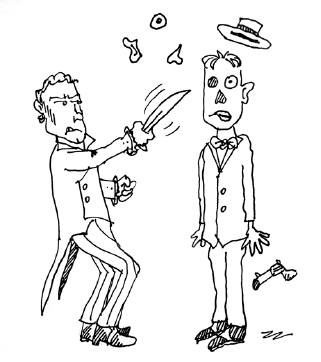
A couple of years later, a mob broke into the Lexington office where Clay published his antislavery newspaper, the True American, and made off with his printing press. It is worth noting that they waited until Clay was bedfast with typhoid fever before attempting such a move. Clays most serious fight came on June 15, 1849, when he insisted on making an antislavery speech at a proslavery rally at Foxtown, Madison County. A riot ensued, during which an enemy stabbed Clay in the side with his own knife. When he regained control of the weapon, Clay sank it into the abdomen of another attacker, Squire Turner. Turner died thirty-two hours later and Clay required several months to recover.
In addition to these adventures, Clay was also an early co-founder of the Republican Party. His campaigning on behalf of Abraham Lincoln in 1860 resulted in the president naming Clay the minister plenipotentiary to Russia, where he served from 1861 to 1869. He got along well with Czar Alexander II and was instrumental in preventing Russia from siding with the Confederacy during the Civil War. Clay always maintained that he, not Secretary of State William Seward, should have been given credit for persuading the czar to sell Alaska to the United States.
Something now must be said of Clays remarkable house in Madison County, located eleven miles north of Richmond. The original house was built in 1798 by Clays father, who called it Clermont. While Cassius was in Russia, his wife, Mary Jane Warfield Clay, supervised an architectural expansion of the house. As a result, Clermont went from two stories to three and from eight rooms to forty-four, including the walk-in closets. It was one of the first houses in America to feature central heating and indoor plumbing, which consisted of a flushing commode, a sink and a bathtubeach in its own separate, adjoining room. At some indeterminate point, the house became known as White Hall rather than Clermont.
Next page
